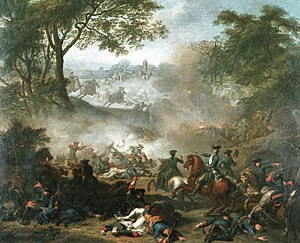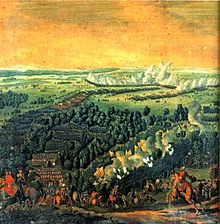Battle of Lesnaya
| date | October 9, 1708 |
|---|---|
| place | Lesnaya , Belarus |
| output | Russian victory |
| Parties to the conflict | |
|---|---|
| Commander | |
| Troop strength | |
| 8,300 men | 12,000-14,500 men |
| losses | |
|
6,397 dead, wounded and prisoners |
1,111 dead |
1st phase: Swedish dominance (1700–1709)
Riga I • Jungfernhof • Varja • Pühhajoggi • Narva • Pechora • Düna • Rauge • Erastfer • Hummelshof • Embach • Tartu • Narva II • Wesenberg I • Wesenberg II
Arkhangelsk • Lake Ladoga • Nöteborg • Nyenschanz • Neva • Systerbäck • Petersburg • Vyborg I • Porvoo • Neva II • Koporje II • Kolkanpää
Vilnius • Salads • Jacobstadt • Walled Courtyard • Mitau • Grodno I • Olkieniki • Nyaswisch • Klezk • Ljachavichy
Klissow • Pułtusk • Thorn • Lemberg • Warsaw • Posen • Punitz • Tillendorf • Rakowitz • Praga • Fraustadt • Kalisch
Grodno II • Golovchin • Moljatichi • Rajowka • Lesnaja • Desna • Baturyn • Koniecpol • Weprik • Opischnja • Krasnokutsk • Sokolki • Poltava I • Poltava II
2nd phase: Sweden on the defensive (1710–1721)
Riga II • Vyborg II • Pernau • Kexholm • Reval • Hogland • Pälkäne • Storkyro • Nyslott • Hanko
Helsingborg • Køge Bay • Gulf of Bothnia • Frederikshald I • Dynekilen Fjord • Gothenburg I • Strömstad • Trondheim • Frederikshald II • Marstrand • Ösel • Gothenburg II • Södra Stäket • Grönham • Sundsvall
Elbing • Wismar I • Lübow • Stralsund I • Greifswalder Bodden I • Stade • Rügen • Gadebusch • Altona • Tönning II • Stettin • Fehmarn • Wismar II • Stralsund II • Jasmund • Peenemünde • Greifswalder Bodden II • Stresow
The Battle of Lesnaya was a battle during the Russian campaign of the Swedish King Charles XII. in the Great Northern War . It took place on September 28th . / September 29, Sweden / October 9, 1708 greg. near the village of Lesnaya (now part of Mahiljou , Belarus ). The Russian troops under the command of Tsar Peter I and Field Marshal Menshikov defeated a Swedish army under the command of General Adam Ludwig Lewenhaupt .
prehistory
Lewenhaupt commanded one of the best Swedish armies, which was stationed near the port city of Riga and was able to successfully repel Russian advances to Courland and Lithuania in previous years (including the Battle of Jakobstadt , Battle of Gemäuterhof ). In the summer of 1708 he moved his troops on the orders of the Swedish King Charles XII. in a southerly direction to join Charles’s main troops stationed in Poland. His entire invasion army, with which the king marched from Saxony to Moscow in September 1707 , meanwhile consisted of almost 70,000 soldiers.
The main Swedish army suffered from considerable supply problems as the Russian troops used the vastness of the country and steadily withdrew, consistently using the scorched earth tactics. Karl therefore urgently awaited the troops under Lewenhaupt's command as well as supplies of ammunition and equipment, in order to then continue the campaign towards Moscow.
The preparations for the departure of Lewenhaupt's troops took longer than expected and the necessary reinforcement was delayed. After long weeks of unsuccessful waiting, Karl decided to invade Ukraine and gave his troops on July 15th . / 16.Swedish / 26th September 1708 greg. the order to march. Lewenhaupt's troops were only about 80 miles from the main troops' position at this point .
He and Tsar Peter I ordered an immediate attack on the smaller Swedish army before it could unite with the main troops. Together with his closest confidante, Menshikov, whom he had made Duke of Ingermanland after the victory in the Battle of Kalisch (1706) , the Tsar himself took command of ten battalions of his most experienced troops, ten dragoons and four batteries of mounted artillery, a total of 11,625 Man. The Russian troops were to make a quick maneuver to cut off Lewenhaupt's troops. Lewenhaupt's troops consisted of 7,500 infantry and 5,000 riders who accompanied a supply train with almost 1,000 cars. On September 18, Jul. the Swedes reached the Dnieper . The crossing over the river dragged on for a whole week, during which the Russians approached the Swedes. On September 27th Jul. the Swedes were overtaken by the village of Lesnaya.
Course of the battle
The battle started around 11 a.m. and the Swedes were pushed back against the village of Lesnaya. From 3 p.m. to 4 p.m., the fighting ceased to a large extent to allow the exhausted troops on both sides to rest. Meanwhile the Russians received reinforcements from 4,000 dragoons. During the day there was a snow storm, which at the end of September was very unusual for Russian weather conditions. When night fell, the Swedes still held their positions. Lewenhaupt decided to retreat across the river at night. The army marched to Propolsk, where they found the bridge destroyed. Lewenhaupt ordered the destruction of most of the supply cars and their cargo. On their further march to the main army, the Swedes lost more soldiers as dispersed and through attacks by the Russians.
In total, the Swedes lost 6,307 soldiers, more than half of whom were captured. The rest of the troops, around 6000 men, reached the Swedish main army on July 8th . / 9th Swedish / 19th October 1708 greg. near the village of Starodub , 60 kilometers west of the Desna tributary .
consequences
The victory at the Battle of Lesnaya brought great moral reinforcement to the Russians, because Levenhaupt's troops had been undefeated for the past nine years and were considered the best in the Swedish army. According to the Russian view, the victory contributed to the victory of the Russians in the Battle of Poltava , in which 9 months later the Swedish army of King Charles XII. was crushed. Peter I the Great later called this battle "The Mother of the Battle of Poltava".
Individual evidence
- ↑ Bengt Liljegren: Karl XII: En Biografi. Historiska media, Lund 2000, ISBN 91-88930-99-8 , p. 162. (Swedish)
- ↑ a b A. V. Agrashenkov, RV Tikhomirov and others: Sto velikikh bitv. Veche, Moscow 2004, ISBN 5-9533-0493-5 , p. 222. (Russian)
- ↑ Bengt Liljegren: Karl XII: En biografi. 2000, p. 151.


